
Buddhist
monks pray during Makha Bucha Day in Chiang Mai, Thailand, to honor
Buddha and his teachings on the day of the full moon in the third lunar
month: photo by Athit Perawongmetha/Reuters, 22 February 2016

Buddhist
monks pray during Makha Bucha Day in Chiang Mai, Thailand, to honor
Buddha and his teachings on the day of the full moon in the third lunar
month: photo by Athit Perawongmetha/Reuters, 22 February 2016

Ban Hat Sieo, Thailand. A Thai Buddhist monk-to-be wearing a colourful traditional costume tumbles as he rides an elephant to bathe during an annual procession at Yom river: photo by Pongmanat Tasiri/EPA via the Guardian, 7 April 2015

Ban Hat Sieo, Thailand. A Thai Buddhist monk-to-be wearing a colourful traditional costume tumbles as he rides an elephant to bathe during an annual procession at Yom river: photo by Pongmanat Tasiri/EPA via the Guardian, 7 April 2015
Mindful Tiger Temple Holocaust

In this 12 February 2015 file photo a Thai Buddhist monk gives water to a
tiger from a bottle at the "Tiger Temple" in Saiyok district in
Kanchanaburi province, west of Bangkok, Thailand. Wildlife officials
have begun removing some of the 137 tigers held at the Buddhist temple
after accusations that their caretakers were involved in illegal
breeding and trafficking of the animals, as well as neglected them.
Teunjai Noochdumrong, assistant deputy director of the Department of
National Parks, said three tigers had been tranquilized and transported
Monday, May 30, 2016, in an operation involving about 1,000 state
personnel and expected to go on for a week.: photo by Sakchai Lalit/AP, 12 February 2015

The carcasses of 40 tiger cubs found undeclared are displayed at the Wat Pha Luang Ta Bua Tiger Temple on June 1, 2016 in Kanchanaburi province, Thailand. Wildlife authorities in Thailand raided a Buddhist temple in Kanchanaburi province where 137 tigers were kept, following accusations the monks were illegally breeding and trafficking endangered animals. Forty of the 137 tigers were rescued by Tuesday from the country’s infamous ‘Tiger Temple’ despite opposition from the temple authorities.: photo by Thailand Department of National Parks, Wildlife and Plant Conservation via CNN, 1 June 2016
Bodies of 40 tiger cubs found in Thai temple freezer: Tassanee Vejpongsa, Associated Press, 1 June 2016
BANGKOK — Forty dead tiger cubs were found Wednesday in a freezer at a Buddhist temple that operated as an admission-charging zoo, a national parks official said.
The discovery happened while authorities were removing mostly full-grown live tigers from the temple in western Kanchanaburi province following accusations that monks were involved in illegal breeding and trafficking of the animals.
The cubs were found in a freezer where the temple staff kept food, said Anusorn Noochdumrong, an official from the Department of National Parks who has been overseeing the transfer of the temple's 137 tigers to shelters. Since Monday, 60 have been tranquilized and removed.
"We don't know why the temple decided to keep these cubs in the freezer," Anusorn said.
"We will collect these carcasses for DNA analysis."
The cubs appeared to be up to a week old, he said. Authorities plan to file charges against the temple for illegally possessing endangered species, he said.
The temple's Facebook page said in March that the temple's former vet had decided in 2010 to stop cremating cubs that died soon after birth. Calls to the temple's office were not answered.
The temple, a popular tourist attraction, has been criticized by animal rights activists because of allegations it is not properly set up to care for the animals and flouted regulations restricting the trade of tigers.
The monks resisted previous efforts to take away the tigers, but relented this week after police obtained a court order.
The temple recently made arrangements to operate as a zoo, but the plan fell through when the government determined that the operators failed to secure sufficient resources.

The carcasses of 40 tiger cubs were found at Wat Pha Luang Ta Bua, a
Buddhist site widely known as the Tiger Temple, in Kanchanaburi,
Thailand: photo by
Dario Pignatelli via The New York Times, 1 June 2016
 .
.
The carcasses of 40 tiger cubs were found at Wat Pha Luang Ta Bua, a Buddhist site widely known as the Tiger Temple, in Kanchanaburi, Thailand: photo by Dario Pignatelli via The New York Times, 1 June 2016
 .
. The carcasses of 40 tiger cubs were found at Wat Pha Luang Ta Bua, a Buddhist site widely known as the Tiger Temple, in Kanchanaburi, Thailand: photo by Dario Pignatelli via The New York Times, 1 June 2016

The carcasses of 40 tiger cubs were found at Wat Pha Luang Ta Bua, a Buddhist site widely known as the Tiger Temple, in Kanchanaburi, Thailand: photo by Dario Pignatelli/The New York Times, 1 June 2016
Thai Officials Find 40 Dead Cubs in Freezer at Tiger Temple: Richard C. Paddock, The New York Times, 1 June 2016
BANGKOK
— The Thai wildlife authorities found 40 dead tiger cubs in a freezer
on Wednesday at the Tiger Temple, a controversial tourist attraction in
western Thailand, and were investigating whether the carcasses were
evidence of the temple’s involvement in the illegal wildlife trade.
The
discovery came as Thai wildlife rangers were removing adult tigers from
the temple in an effort to shut down the attraction after receiving
complaints that the temple was trafficking in endangered species.
The temple, a Buddhist monastery that offered tourists close contact with tigers,
has long been accused by conservationists and animal rights activists
of exploiting and abusing the animals, accusations the temple has
denied.
Wildlife
officials said that only one of the dead cubs found on Wednesday had
been reported to the government as required by law and that the police
were investigating.
Tiger
parts, while illegal to sell, are in high demand in Asia, particularly
China, for use in traditional medicine. There is even a market for
frozen tiger cubs, as the arrest last month of a Vietnamese man carrying
four of them attests.
Representatives
of the temple, Wat Pha Luang Ta Bua, said that Thailand’s Wildlife
Conservation Office had been notified of all of the cubs’ births and
deaths and that the bodies were kept as proof that none of them were
sold on the black market.
“We
have declared all the deaths to the officials over years,” said
Supitpong Pakdjarung, a former police colonel who runs the temple’s
business operation. “They’ve known about these carcasses for a long
time.”
The temple has promoted itself as a spiritual center where
people and tigers lived in harmony, and it has charged tourists as much
as $140 apiece for the chance to bathe, hand-feed and play with the
tigers.
The temple has promoted itself as a spiritual center where
people and tigers lived in harmony, and has charged tourists as much
as $140 apiece for the chance to play with the
tigers
The
temple was already under investigation on suspicion of illegally
trading in tigers after a former veterinarian reported that three live
adult tigers had vanished.
Adisorn
Noochdumrong, deputy director general of the Department of National
Parks, Wildlife and Plant Conservation, which oversees the Wildlife
Conservation Office, said a temple staff member had told the authorities
about the dead cubs in the freezer.
“We just found them this morning,” Mr. Adisorn said. “There are 40 tiger cubs.”
He said the department would perform DNA tests on the seized tigers and the dead cubs to see how they might be related.
Temple
officials, however, denied any wrongdoing. Mr. Supitpong said he
notified officials in December when they came to see how many tigers
were at the temple.
“We just found them this morning. There are 40 tiger cubs.”
In a Facebook post
in March, the temple said that it was normal for some cubs to die and
that the staff had been preserving the carcasses since 2010. The post
gave no indication of how many deceased cubs there were.
Teunchai
Noochdumrong, director of Thailand’s Wildlife Conservation Office and
the wife of Mr. Adisorn, said the cubs did not appear to be missing any
parts. There was no indication yet how they died, she said.
Debbie
Banks, campaign leader on tigers and wildlife crime for the
London-based Environmental Investigative Agency, said the discovery of
the cubs was disturbing given the underground market in frozen cubs.
While
adult tigers have more value, particularly for their pelts, teeth and
claws, the cubs can be sold for their meat and for their bones, which
are said to have medicinal value, she said.
Tiger
cubs also are sold in large jars of wine, either on their own or with
bear paws, snakes and scorpions, she said. Some people believe such
“wildlife wine” provides a health benefit, she said.
Zoos
that offer tourists close contact with the animals and selfie
opportunities are often fronts for breeding operations that supply the
black market trade, Ms. Banks said.
“Forty
frozen tiger cubs? Why would you keep them? It suggests something far more sinister.”
“Forty
frozen tiger cubs?” she asked. “Why would you keep them? When we know
there is a market for frozen tiger cubs, it raises a lot of issues. I
think it suggests something far more sinister.”
At
its peak, the temple reported having 148 tigers, nearly all of them
adults. The wildlife agency seized 10 of the big cats earlier this year
before the temple won a court order halting the operation. After the
authorities successfully challenged that order, they resumed removing
the animals on Monday.
By
Wednesday evening, rangers had taken 64 more tigers, Ms. Teunchai said.
The authorities estimated that 73 tigers remained at the zoo and hoped
to have all of them removed by Saturday. They said that the temple
lacked documentation proving ownership of the tigers and that therefore,
under Thai endangered species law, they belonged to the government.
By
Wednesday, Mr. Supitpong appeared resigned to the tigers’ removal and
the closure of the temple’s tourist attraction. The temple recently won
approval to build and operate a zoo on a nearby site, and Mr. Supitpong
said he was ready to move forward with that plan.
“Right
now, we want everything to come to an end,” he said. “Please hurry and
remove all the tigers. Once the state tigers are all removed, we will
proceed with the zoo.”
The Heat Closing In On Mindful Tiger Temple

Officials prepare weapons with a sedation as they start moving tigers from Thailand's controversial Tiger Temple, a popular tourist destination which has come under fire in recent years over the welfare of its big cats in Kanchanaburi province, west of Bangkok, Thailand. Wildlife authorities raid a Buddhist temple that has more than 100 tigers, taking away three cats and vowing to confiscate scores more in response to global pressure over wildlife trafficking.: photo by Chaiwat Subprasom/Reuters, 30 May 2016

A Buddhist monk walks past a chained and sedated tiger before officials start moving tigers from Thailand's controversial Tiger Temple, a popular tourist destination which has come under fire in recent years over the welfare of its big cats in Kanchanaburi province, west of Bangkok, Thailand: photo by Chaiwat Subprasom/Reuters, 30 May 2016

A tourist poses next to a a chained and sedated tiger before officials start moving tigers from Thailand's controversial Tiger Temple, a popular tourist destination which has come under fire in recent years over the welfare of its big cats in Kanchanaburi province, west of Bangkok, Thailand: photo by Chaiwat Subprasom/Reuters, 30 May 2016

A sedated tiger is stretchered as officials start moving tigers from Thailand's controversial Tiger Temple, a popular tourist destination which has come under fire in recent years over the welfare of its big cats in Kanchanaburi province, west of Bangkok, Thailand: photo by Chaiwat Subprasom/Reuters, 30 May 2016

A sedated tiger is stretchered as officials start moving tigers from Tiger Temple. The government introduced new animal welfare laws in 2015 aimed at curbing animal abuse, but activists accuse authorities of not enforcing the legislation properly.: photo by Chaiwat Subprasom/Reuters, 30 May 2016

A sedated tiger is stretchered as officials start moving tigers from Tiger Temple. The Buddhist temple in Kanchanaburi province west of Bangkok has more than 100 tigers and has become a tourist destination where visitors take selfies with tigers and bottle-feed their cubs.: photo by Chaiwat Subprasom/Reuters, 30 May 2016

Officials try to lead a tiger into a cage as they start moving tigers from Tiger Temple, May 30, 2016. Wildlife activists have accused the temple's monks of illegally breeding tigers, while some visitors have said the animals can appear drugged. The temple denies the accusations.: photo by Chaiwat Subprasom/Reuters, 30 May 2016

A sedated tiger is stretchered as officials start moving tigers from Tiger Temple: photo by Chaiwat Subprasom/Reuters, 30 May 2016

A sedated tiger is seen in a cage as officials start moving tigers from Thailand's controversial Tiger Temple, a popular tourist destination which has come under fire in recent years over the welfare of its big cats in Kanchanaburi province, west of Bangkok, Thailand: photo by Chaiwat Subprasom/Reuters, 30 May 2016

A sedated tiger is placed on a stretcher as officials start removing tigers from Thailand's controversial temple in Kanchanaburi province: photo by Chaiwat Subprasom / Reuters, 30 May 2016
Big cats removed from Thailand's infamous Tiger Temple: Patpicha Tanakasempipat, Reuters, 31 May 2016
KANCHANABURI, Thailand -- Wildlife authorities in Thailand have raided a Buddhist temple where tigers are kept, taking away 40 of the animals by Tuesday and vowing to confiscate scores more in response to global pressure over wildlife trafficking.The Buddhist temple in Kanchanaburi province west of Bangkok had more than 130 tigers and had become a tourist destination where visitors took selfies with tigers and bottle-fed cubs.
The temple promoted itself as a wildlife sanctuary, but in recent years it had been investigated for suspected links to wildlife trafficking and animal abuse.
Wildlife activists have accused the temple's monks of illegally breeding tigers, while some visitors have said the animals can appear drugged. The temple denies the accusations.
The raid, which began on Monday, was the latest move by authorities in a tug-of-war since 2001 to bring the tigers under state control.
Adisorn Nuchdamrong, deputy director-general of the Department of National Parks, said his team was able to confiscate the tigers thanks to a warrant obtained a few hours before the operation began.
We have a court warrant this time, unlike previous times, when we only asked for the temple's cooperation, which did not work," Adisorn told Reuters.
"International pressure concerning illegal wildlife trafficking is also part of why we're acting now."
Monks at the temple were not available for comment
Officials moved seven tigers from the temple on Monday and 33 on Tuesday, leaving 97 still there.
Adisorn said the department planned to remove all of the tigers and send them to state-owned sanctuaries. Officials also found also found six hornbills, which are protected birds, at a monk's residence, he said.
Monks at the temple were not available for comment.
Previous attempts to inspect the tigers were largely blocked by the temple's abbots but in January and February wildlife officials removed 10 tigers.
Thailand has long been a hub for the illicit trafficking of wildlife and forest products, including ivory. Exotic birds, mammals and reptiles, some of them endangered species, can often be found on sale in markets.
The government introduced new animal welfare laws in 2015 aimed at curbing animal abuse, but activists accuse authorities of not enforcing the legislation.
The group People for the Ethical Treatment of Animals said the temple was "hell for animals", which spent much of their lives in cement cells.
"The tigers ... should be transferred to suitable sanctuaries and facilities that can offer them a better life," the group said in its statement.
It called on tourists to stop visiting animal attractions at home or abroad.
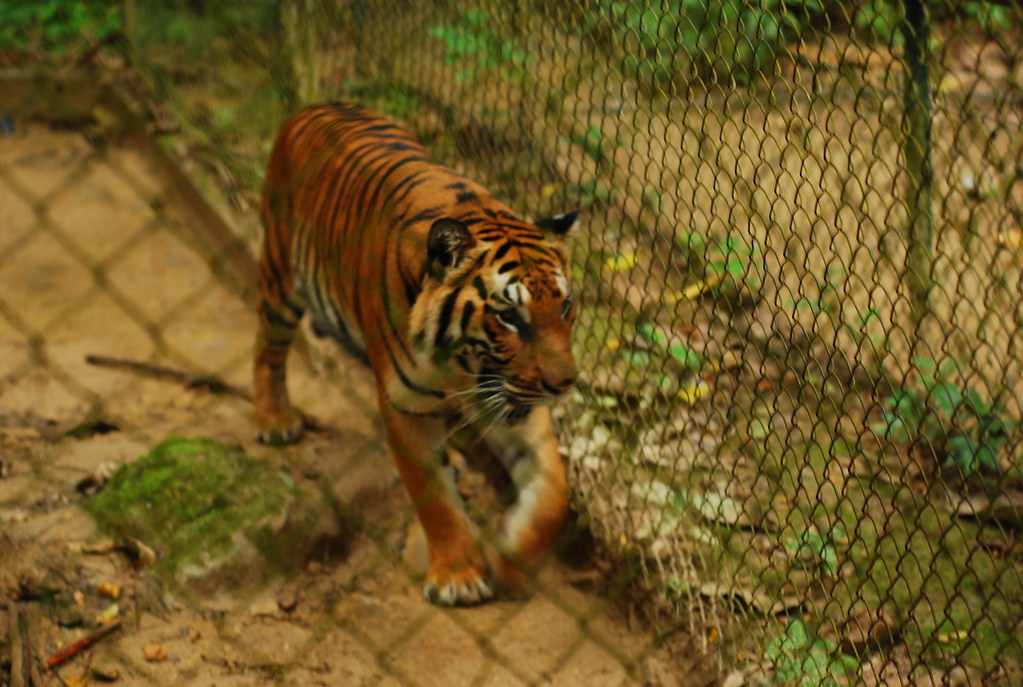
Phet -- the Indochinese Tiger. Phet is a victim of illegal wildlife trade. Her mother was killed by poachers in February 2000. Her two brothers also did not survive. By the time she was just four days old, Phet had already been sold on four times by illegal traders. Capture stress, malnutrition, ringworm infestation and diarrhea had taken their toll on Phet. She was in extremely poor condition and had lost most of her hair when she was rescued. Phet has made a full recovery thanks to CWI's Tiger Adoption Programme. She will depend on human care for the rest of her life: photo by Mikhail Esteves, 15 October, 2007
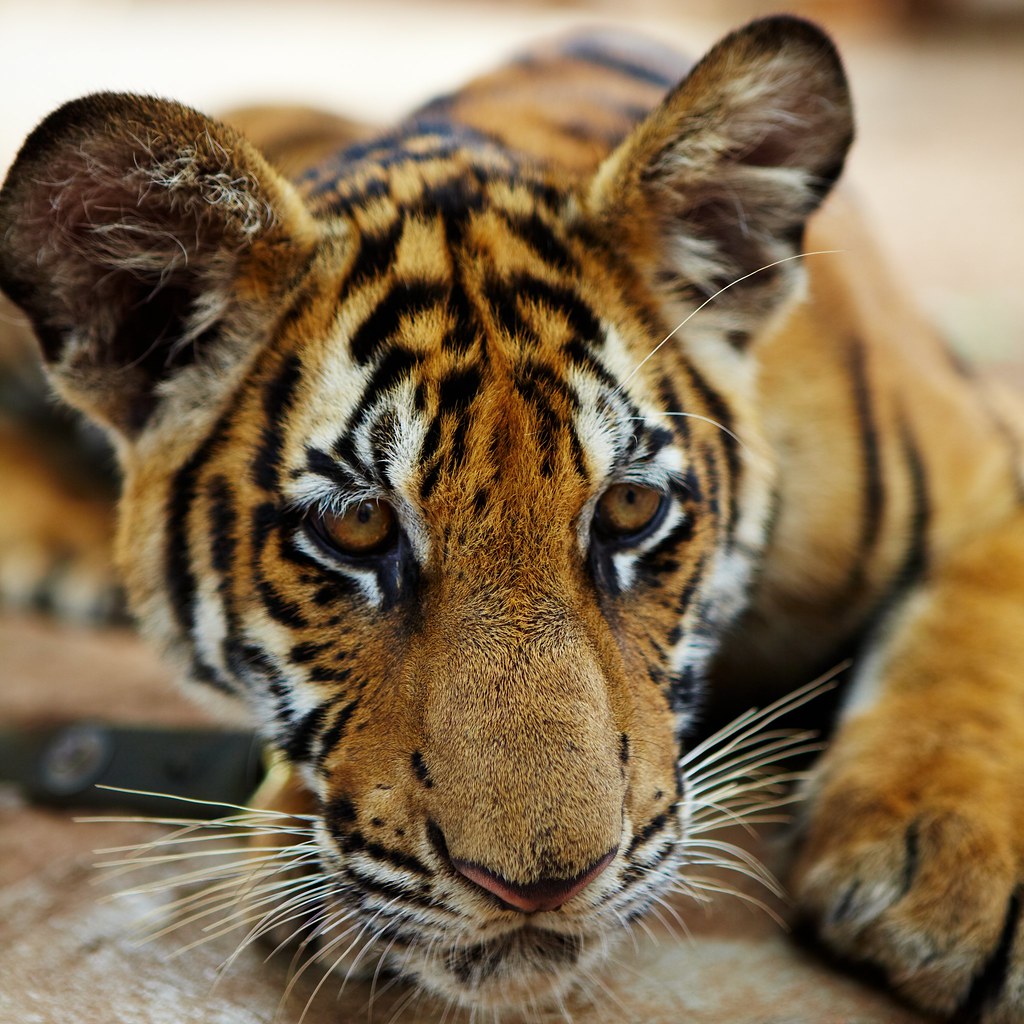
Captured tiger cub, Thailand. This poor guy was at the "Tiger Temple" in Kanchanaburi province, Thailand. I don't recommend this trip at all. Although it sounds nice touching the tigers and taking their pictures it's not as cool as you may think. The big tigers look as if on drugs and they just lie there sleeping all day. It looks sad and somehow you feel that these animals are used commercially just to bring money to the monks. Some other people in this region started capturing/buying/getting tigers and now they are happy to present those in cages for tourists -- for money of course. It's very different than in a Zoo, at least in a Zoo they have a relatively big area for the tigers to move and are being taken care by professionals. Here are approx 15 tigers in chains -- the big ones sleeping all the time (strange) and tons of people visiting every day putting money in this monastery. I understand it's hot and the tigers have to do this every day, probably are very bored, but not a single tiger moving from approx 10 adults? Second, you are not allowed to take pictures of the big tigers (Imagine my shock to hear that after traveling so much). Some volunteer will take your hand and bring you behind the sleeping tigers and another volunteer will take your camera and take some snapshots of you touching the tiger. You do this for approx 5 big sleeping tigers, 2 photos per each tiger (one landscape and one portrait). Or you can buy the "Special Photo" treatment and they take the sleeping tiger head and put it in your lap and somebody takes a photo of that. My photos are with the tiger cubs, these have a different treatment than the adults. At least these seem like normal "alive" animals -- but still in chains.: photo by photo by Pavel, 9 September 2009

Tiger Temple, Kanchanaburi province, Thailand: photo by brett marlow, 22 February 2008

Captured Tiger Cub, Thailand: photo by Pavel, 9 September 2009
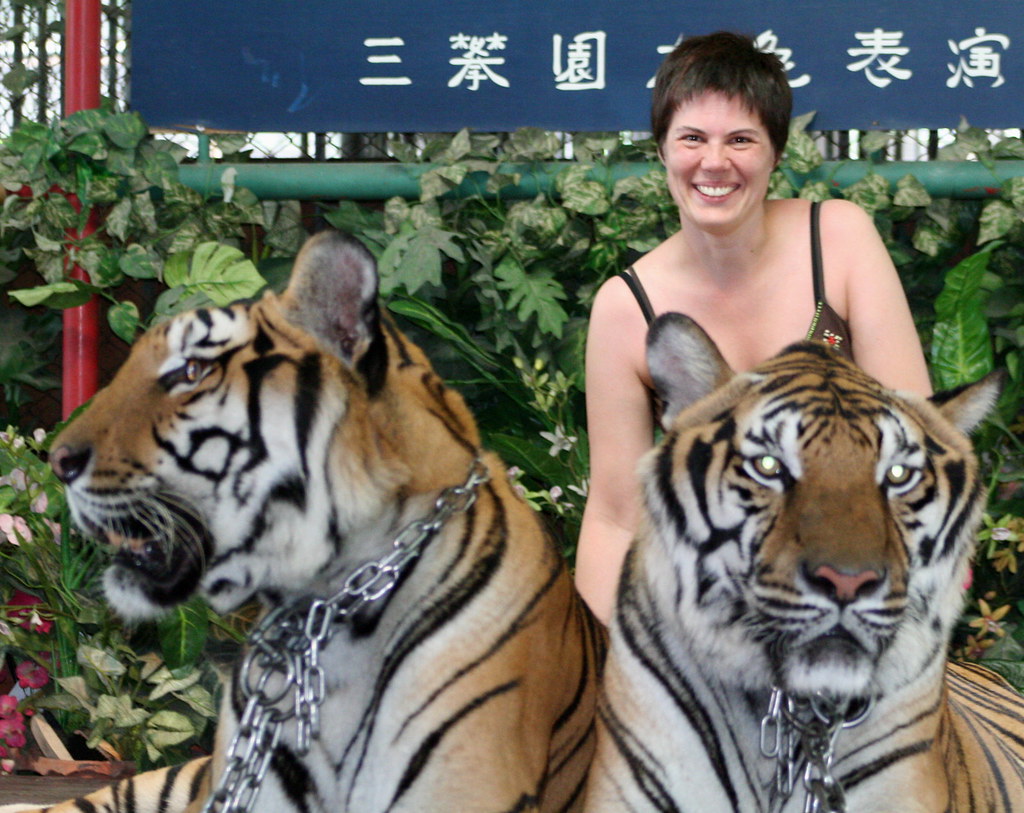
The tigers and me. At a zoo of sorts in Thailand -- it was billed as a Crocodile Farm, but there were two gorgeous tigers and some elephants that made the crocodiles seem boring: photo by Roberta Taylor, 9 May 2008
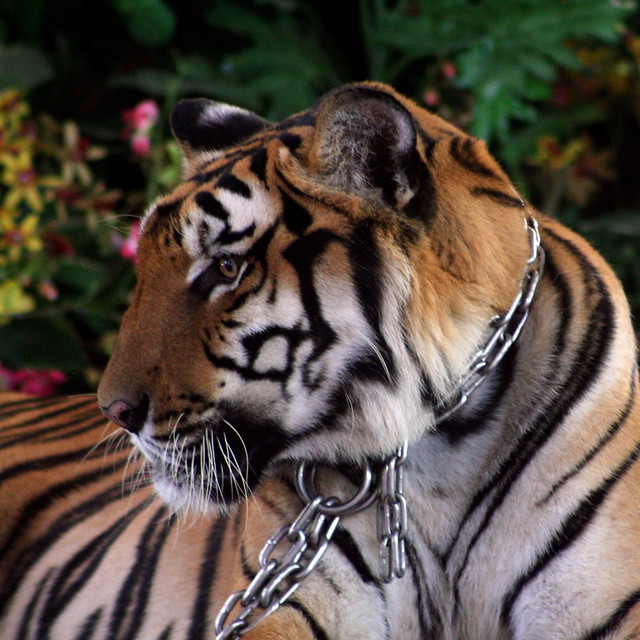
Beautiful [Captive tiger, Thailand]: photo by Roberta Taylor, 9 May 2008
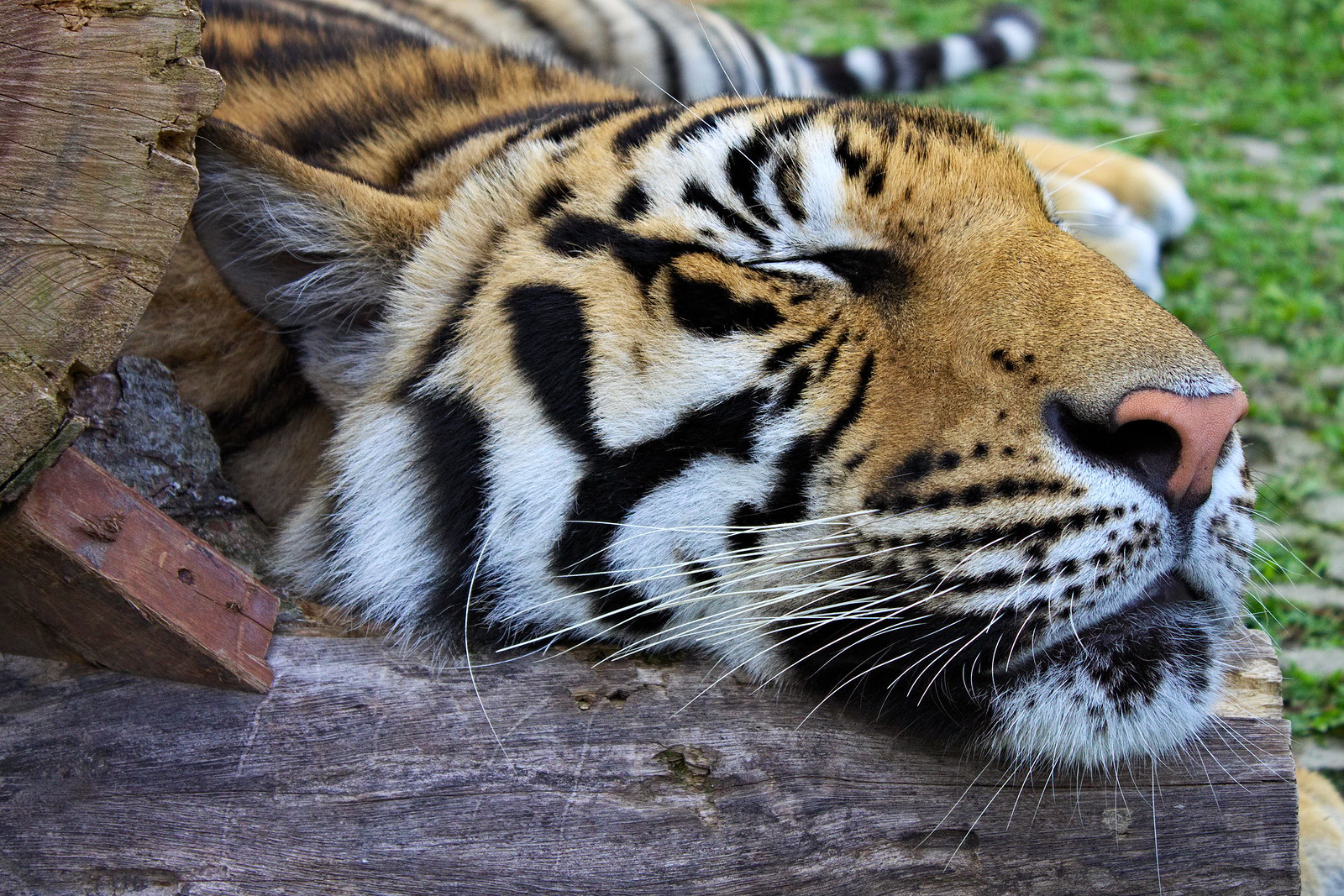
Tiger, Tiger Kingdom, Phuket, Thailand: photo by Nicholas Vollmer, 14 January 2014

sedated tiger, Chiang Mai, Thailand: photo by garycycles7, 3 May 2011
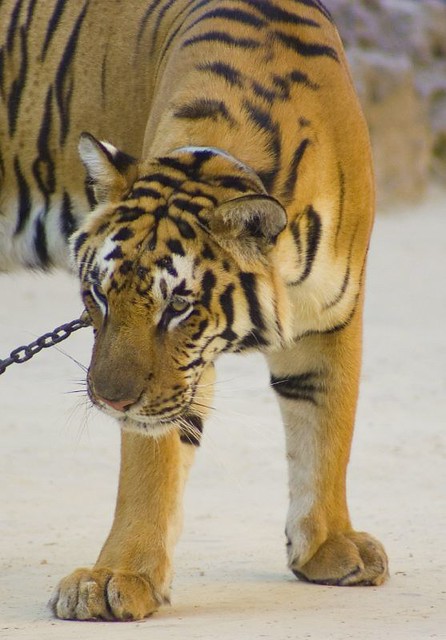
Tiger Temple 3 [Kanchanaburi Province, Thailand]: photo by audrey_sel, 2 January 2007
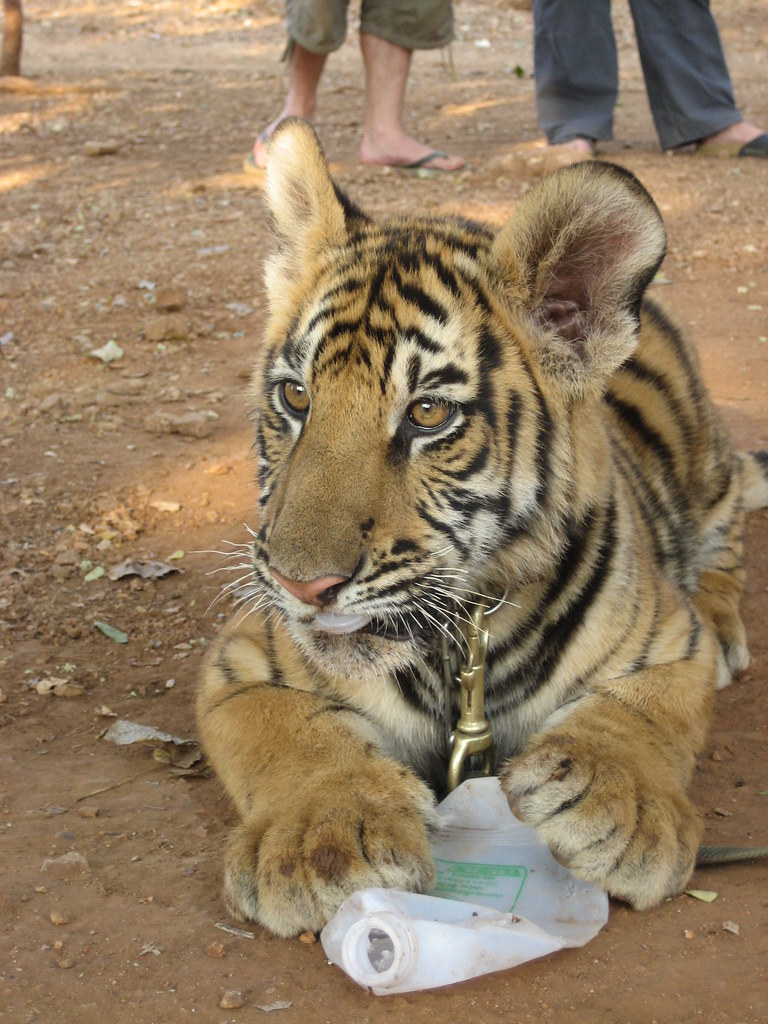
Baby Tiger (Tiger Temple, Kanchanaburi Province, Thailand): photo by rogoyski, 3 January 2008

Tiger Temple, Kanchanaburi Province, Thailand: photo by SB, 21 November 2005
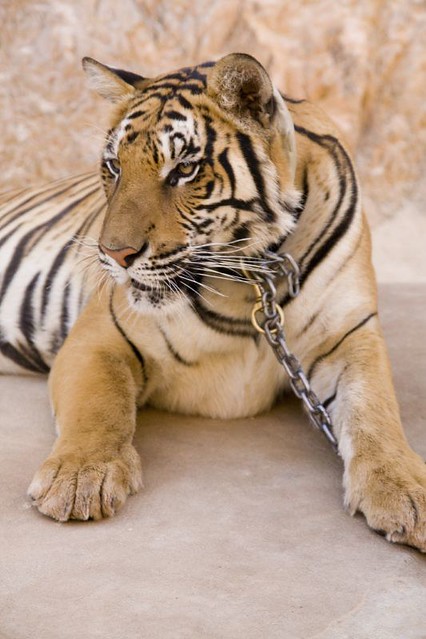
Tiger Temple 7 [Kanchanaburi Province, Thailand]: photo by audrey_sel, 2 January 2007
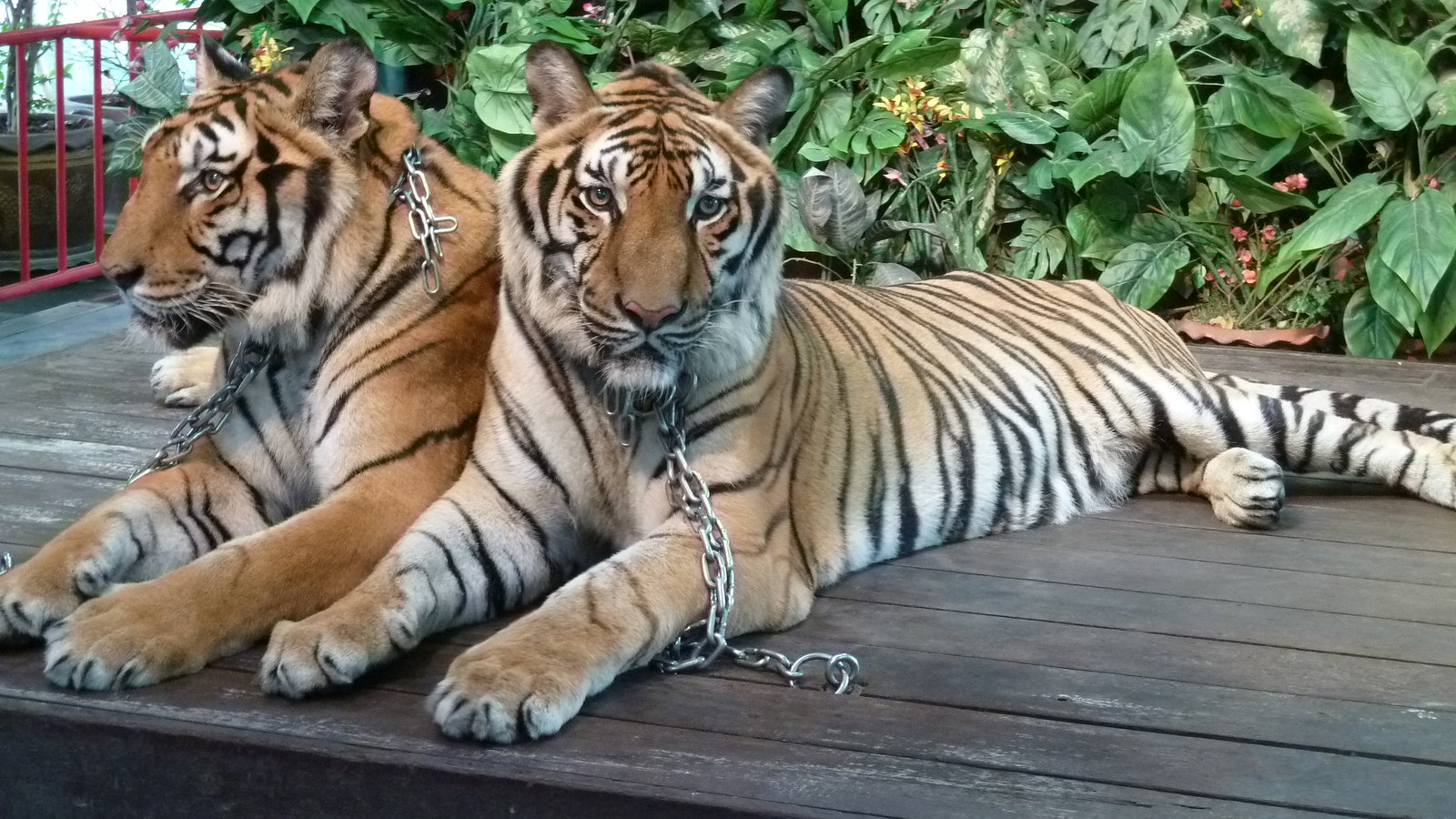
Tigers, Samphran Elephant Ground and Zoo, Ban Phaeo, Samut Sakran, Thailand: photo by Sophia Lucero, 3 June 2011
Burning Down the Mindful Tiger Temple Con

An enclosure at the Tiger Temple, an attraction in western Thailand that is affiliated with influential Buddhist monks.: photo by Amanda Mustard for The New York Times, 1 May 2016

An enclosure at the Tiger Temple, an attraction in western Thailand that is affiliated with influential Buddhist monks.: photo by Amanda Mustard for The New York Times, 1 May 2016
Thai Officials Battle Buddhist Monks Over Tigers’ Fate: Richard C. Paddock, The New York Times, 1 May 2016
SAI
YOK, Thailand — Saira Tahir, a London lawyer, waved a bamboo pole with a
plastic bag affixed to the end high in the air. A 200-pound tiger leapt
and swatted it like a house cat batting a string toy.
For
her $140 premium admission, Ms. Tahir also bathed a tiger, bottle-fed a
cub and posed for a photo with a tiger’s head in her lap.
“It’s
a surreal experience being so close to them,” she said. “Even with the
tiger’s head in your lap, you can feel the energy. It’s not something
you do every day.”
An
Edenesque wildlife fantasy
Part Buddhist monastery and part petting zoo, the Tiger Temple in western Thailand
has long been the bane of conservationists and animal rights activists
who accuse it of abuse and exploitation even as it offers tourists an
Edenesque wildlife fantasy.
Now,
after complaints of trafficking in endangered species, the government
is trying to shut down the attraction. But there are two major
obstacles: the temple, which has gone to court to block the closing, and
the tigers. What do you do with nearly 150 carnivorous cats raised in
captivity?
The
government began removing the tigers this year but was ordered to stop
after the lawsuit was filed in February. Until the case is resolved, the
fate of the tigers is mired in a legal standoff that pits wildlife
officials, conservationists and Thailand’s military government against a
wealthy tourist enterprise backed by influential Buddhist monks.
The
Tiger Temple, in rural Kanchanaburi Province near the Myanmar border,
started collecting animals 15 years ago with an act of charity.
Villagers took an injured tiger cub to the local abbot, who agreed to
care for it. Word spread, and soon there were six tigers.
The tourists came next
“We
built this temple to spread Buddhism,” said Supitpong Pakdjarung, a
former police colonel who runs the temple’s business arm. “The tigers
came by themselves.”
The
tourists came next. Today, the temple takes in $5.7 million a year from
ticket sales, wildlife officials say, and receives millions more in
donations. A standard ticket, about $17, entitles a visitor to walk a
leashed tiger and pose with a chained tiger.
The
15 or so monks who live on the grounds have little to do with the
tigers beyond occasionally posing with them for tourists. But a Buddhist
atmosphere is part of the pitch. The temple promotes itself as a place
where tigers betray their wild nature to coexist with humans in Buddhist
harmony.
“We can live together peacefully because of kindness,” Mr. Supitpong said.
A Buddhist
atmosphere is part of the pitch
Some
monks and staff members believe that certain tigers are reincarnated
monks or relatives. Mr. Supitpong said that through meditation, monks
had come up with dietary solutions to repair genetic defects from
inbreeding.
“It is a spiritual connection,” he said.
The
Buddhist imprimatur also makes the temple a powerful adversary in its
legal battle with the government. In Thailand, the moral authority of
monks rivals the secular authority of the law.
“They
have the power to say right or wrong in terms of morality,” said
Surapot Taweesak, a scholar in philosophy and religion at Suan Dusit
Rajabhat University in Bangkok. “This makes people listen and not dare
to argue or debate with monks for fear of being sinful.”
The
government has ordered the temple to stop breeding tigers, charging
fees to tourists and letting visitors feed tigers, officials say, but
the temple has refused.
“The
monks have the attitude, ‘I am over the law’”
“The
monks have the attitude, ‘I am over the law,’” said Teunchai
Noochdumrong, the director of Thailand’s Wildlife Conservation Office.
“They say because they are monks, they have the right to take care of
all the animals in that area.”
The abbot, Phra Vissuthisaradhera, is “not a monk,” Ms. Teunchai said. “He’s a criminal.”
Mr. Vissuthisaradhera, who was attacked and clawed on the face last year by his favorite tiger, declined to be interviewed.
For years, the temple has faced allegations of misconduct. Recently, a handler was caught on video punching a tiger in the head.
“We have to
hit them so we can change the tiger’s mood at the moment”
Mr.
Supitpong acknowledges that staff members sometimes have to strike the
tigers to distract them from focusing on tourists as prey. “We have to
hit them so we can change the tiger’s mood at the moment,” he said.
Charges
of tiger smuggling date to at least 2008, when the British group Care
for the Wild said the temple was illegally trading tigers with a farm in
neighboring Laos.
Last
year, the temple’s veterinarian resigned and reported that three tigers
had vanished from the temple. He handed over three microchips that he
said had been removed from the tigers; such chips are used to track
endangered animals.
An
Australian organization, Cee4life, claims that 281 tigers have been
born at the temple over the years and that natural deaths alone could
not account for today’s population, which stands at 138, not counting
the 10 already removed by the government. The organization also
presented evidence that some of the temple’s first tigers had been
caught in the wild and that others had been brought later from Laos.
Copycatting the
temple’s business success
The
temple’s business success has inspired dozens of other operators of
unlicensed zoos to offer tourists close contact with rare animals, said
Edwin Wiek, the founder of the Wildlife Friends Foundation Thailand.
The
animals they breed are unwanted once they mature, Mr. Wiek said,
contributing to Thailand’s role as a global hub for illegal trafficking
in endangered animals.
Tiger
parts are in high demand in Asia, particularly China, for use in
traditional medicine. Tiger bone can fetch as much as $168 a pound, and
tiger penis soup goes for as much as $320 a bowl.
“In the past we called it ‘monks feed tigers.’ But now it’s ‘tigers
feed monks.’”
At
the Tiger Temple, only tigers under age 4 -- there are 16 of them now --
are brought out for tourists. Larger tigers, which can be careless about
the rules of interspecies harmony, are retired to cages.
After
the veterinarian’s accusations, the government revoked the temple’s
permission to keep tigers. The temple lacks documents proving ownership,
so wildlife officials contend that the tigers belong to the government.
Temple
officials deny abusing the tigers or trading in tigers or tiger parts.
They lack ownership papers, they say, because most of the tigers were
born at the temple.
Mr.
Supitpong said that the three tigers suspected to be missing were still
on the premises, and that he had no knowledge of any microchips being
removed.
“We
have received all the funds by the tigers’ virtue”
During
a raid last year, government officials also found eight hornbills and
six Asian black bears, also protected species. The temple said it was
the legitimate owner of those animals, too, but lacked the documents
proving it, Ms. Teunchai said.
When
wildlife officials tried to seize the animals last year, protesting
monks and temple supporters blocked the main road to the temple.
Officials circumvented the protest by driving a crane to the side of the
temple and hoisting the bears over a a 12-foot wall.
Mr.
Supitpong says the temple earns $3 million a year in ticket revenue,
about half what the government says. Most of the donations go toward the
construction of a $29 million temple that is expected to be completed
in 2022, the next Year of the Tiger. The temple will be one of
Thailand’s largest.
“We
have received all the funds by the tigers’ virtue,” Mr. Supitpong said.
“In the past we called it ‘monks feed tigers.’ But now it’s ‘tigers
feed monks.’”
“A tiger is a tiger, not a pet. They have to live their nature.”
There
are about 2,000 captive tigers in Thailand, but most are a mix of
Bengal tigers, a type that is native to the Indian subcontinent, and
Indochinese tigers. Only an estimated 189 Indochinese tigers -- the
subspecies native to the region -- remain in Thailand’s forests.
The crossbred tigers are of no value in protecting the species as a whole, conservationists say.
While
the temple tigers are not domesticated -- their behavior can be
unpredictable, and there have been several attacks on tourists and staff
members -- they are not wild, either, having been raised in
captivity and unafraid of people. If the Tiger Temple is shut down, the
tigers cannot simply be set free in the jungle.
The
10 tigers removed by the government were taken by truck to a government
center, the Khao Prathap Chang Wildlife Breeding Center, in neighboring
Ratchaburi Province, where each has a 430-square-foot cage equipped
with a concrete pool the size of a large bathtub. The cages, unlike
those at the temple, have no access to an enclosure with grass and
trees.
Temple officials insist that tigers are better off at the temple.
“In Thailand, this is the best place for them,” said Tanya Erzinclioglu, a volunteer coordinator.
But
Banpot Maleehuan, the government center’s director, said ending the
tigers’ close contact with people had already been good for them.
“They
have been here two months now, and they are becoming real tigers,” he
said. “A tiger is a tiger, not a pet. They have to live their nature.”

Tigers cool off in a pool at the Tiger Temple, an attraction in western Thailand that officials promote as a place where animals coexist with humans in Buddhist harmony. Conservationists accuse the temple of abuse and exploitation.: photo by Amanda Mustard for The New York Times, 21 May 2016

Tigers cool off in a pool at the Tiger Temple, an attraction in western Thailand that officials promote as a place where animals coexist with humans in Buddhist harmony. Conservationists accuse the temple of abuse and exploitation.: photo by Amanda Mustard for The New York Times, 21 May 2016

A tiger with a handler in an outdoor enclosure at the temple, which began collecting animals 15 years ago when an abbot agreed to care for an injured tiger cub: photo by Amanda Mustard for The New York Times, 21 May 2016

The temple has 138 tigers -- not counting 10 that have been removed by
the government -- and takes in millions of dollars from ticket sales
each year.: photo by
Amanda Mustard for The New York Times, 21 May 2016

The temple has 138 tigers -- not counting 10 that have been removed by the government -- and takes in millions of dollars from ticket sales each year.: photo by Amanda Mustard for The New York Times, 21 May 2016

A monk accompanied tourists and staff members on a walk with one of
the tigers. About 15 monks live on the grounds and have little to do
with the tigers beyond occasionally posing with them for tourists.: photo by
Amanda Mustard for The New York Times, 21 May 2016

A monk accompanied tourists and staff members on a walk with one of the tigers. About 15 monks live on the grounds and have little to do with the tigers beyond occasionally posing with them for tourists.: photo by Amanda Mustard for The New York Times, 21 May 2016

Tourists at the Tiger Temple. The government has ordered the temple to stop breeding tigers, charging fees to tourists and letting visitors feed tigers, officials say, but the temple has refused.: photo by Amanda Mustard for The New York Times, 21 May 2016

Tourists at the Tiger Temple. The government has ordered the temple to stop breeding tigers, charging fees to tourists and letting visitors feed tigers, officials say, but the temple has refused.: photo by Amanda Mustard for The New York Times, 21 May 2016

A staff member taking photos for tourists. A standard ticket, which costs about $17, entitles a visitor to walk a leashed tiger and pose with a chained tiger.: photo by Amanda Mustard for The New York Times, 21 May 2016

A staff member taking photos for tourists. A standard ticket, which costs about $17, entitles a visitor to walk a leashed tiger and pose with a chained tiger.: photo by Amanda Mustard for The New York Times, 21 May 2016

Staff members take tigers back to their enclosures after tourists have posed with them: photo by Amanda Mustard for The New York Times, 21 May 2016

Staff members take tigers back to their enclosures after tourists have posed with them: photo by Amanda Mustard for The New York Times, 21 May 2016

The tigers are kept in cages, although the temple also has large enclosures. “In Thailand, this is the best place for them,” a volunteer coordinator said. Conservationists and the government say otherwise.: photo by Amanda Mustard for The New York Times, 21 May 2016

The tigers are kept in cages, although the temple also has large
enclosures. “In Thailand, this is the best place for them,” a volunteer
coordinator said. Conservationists and the government say otherwise.: photo by
Amanda Mustard for The New York Times, 21 May 2016
BANGKOK — Wildlife authorities seized 33 tigers on Tuesday from a Buddhist temple in western Thailand in an effort to shut down the popular but controversial tourist attraction as early as this week.
Teunchai
Noochdumrong, the director of Thailand’s Wildlife Conservation Office,
said she was optimistic that all of the temple’s tigers, estimated to
total 137, would be removed by Friday, ending a long-running dispute
between the temple and the government.
The
temple, Wat Pha Luang Ta Bua, commonly called the Tiger Temple, began
keeping and breeding tigers 15 years ago and has promoted itself as a
spiritual sanctuary where wild animals and humans can peacefully
coexist. For years, it has been accused of misconduct and trading in
endangered animals. It has earned nearly $6 million a year from ticket
sales, officials said.
The Wildlife Conservation Office this year ordered the temple to stop breeding tigers, selling tickets and allowing tourists to hand-feed the animals, but the temple ignored the orders. Ms. Teunchai has called the temple's abbot “a criminal” and said the monks acted as though they were above the law.
The
temple is also under investigation on suspicion of illegally trading in
tigers after three of the animals vanished from the temple.
“Tomorrow we will have hard work because they unlocked the cages of all the tigers”
The
government seized 10 tigers earlier this year, along with six Asian
black bears and eight hornbills, before the temple won a temporary court
order in February halting the removal of more tigers. At one point,
monks and their supporters blocked the gate to the compound to prevent
officials from taking the animals.
This
week, after the agency obtained a court order directing the temple to
hand over the tigers, the authorities removed seven tigers on Monday and
33 on Tuesday.
Three
hundred agency staff members took part in the roundup, as well as
police officers who were there to maintain order, Ms. Teunchai said.
Workers
at the temple opened the tigers’ cages, allowing them to enter larger
enclosures, making it harder to capture the remaining animals, Ms.
Teunchai said.
“Tomorrow we will have hard work because they unlocked the cages of all the tigers,” she said.
Temple officials could not be reached for comment on Tuesday.
The tigers are being moved to government wildlife centers around the country.

A big cat skeleton -- allegedly a tiger -- in an aquarium of tiger bone wine, at Fantasy Garrett, a restaurant in the Golden Triangle Special Economic Zone: photo by EIA, 19 March 2015




The entrance to the Tiger Temple, which has been accused of mistreating and illegally trading tigers. Temple officials deny the allegations.: photo by Amanda Mustard for The New York Times, 1 May 2016

Thailand’s #TigerTemple under investigation for alleged engagement in illegal #wildlifetrade: image via Animal Protection UK @MoveTheWorldUK, 5 February 2016

A big cat skeleton -- allegedly a tiger -- in an aquarium of tiger bone wine, at Fantasy Garrett, a restaurant in the Golden Triangle Special Economic Zone: photo by EIA, 19 March 2015

A big cat skeleton -- allegedly a tiger -- in an aquarium of tiger bone wine, at Fantasy Garrett, a restaurant in the Golden Triangle Special Economic Zone: photo by EIA, 19 March 2015

A
caged tiger bred for slaughter in the Golden Triangle Special Economic Zone: photo by EIA, 19 March 2015

A
caged tiger bred for slaughter in the Golden Triangle Special Economic Zone: photo by EIA, 19 March 2015

The entrance to the Tiger Temple, which has been accused of mistreating and illegally trading tigers. Temple officials deny the allegations.: photo by Amanda Mustard for The New York Times, 1 May 2016

The entrance to the Tiger Temple, which has been accused of mistreating and
illegally trading tigers. Temple officials deny the allegations.: photo by
Amanda Mustard for The New York Times, 1 May 2016
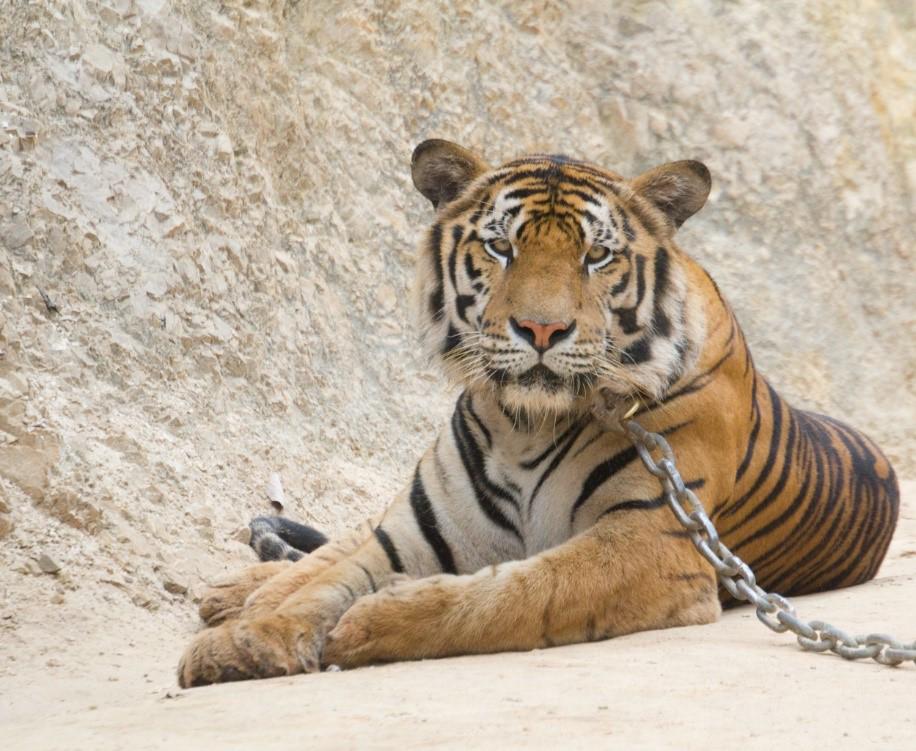



4 comments:
This happened some days ago:
Franco Ferrada, nombre identificado por la policía, ingresó a la jaula de los leones en el Zoológico Nacional en Santiago y en una acción temeraria, los provocó para que lo devoraran. Según antecedentes de Carabineros, el sujeto escaló la reja burlando las medidas de seguridad, forzó la techumbre, se desnudó causando el posterior ataque.
Mientras ocurría la imagen dantesca, un macho y una hembra de león fueron muertos debido a los disparos que percutaron los encargados del zoológico, para rescatar al hombre.
Ferrada fue ingresado de inmediato a la Clínica Indisa, a la UCI. En tanto, Alejandra Montalba, directora del Zoológico Nacional indicó que “lamentamos mucho perder a miembros de nuestra familia, pero tuvimos que actuar con rapidez. El efecto anestésico tarda entre unos 3 ó 4 minutos, tiempo que podemos perder la vida de la persona”.
Montalba dijo que se encontró una carta indicadora de un presunto suicidio en la ropa del individuo.
Sandra,
The idea of using a big cat as a suicide weapon must be uniquely human.
There are thought to be fewer than 180 Indochinese Tigers still alive in the wild in Thailand.
The idea of using them as begging props and marketing adverts for a fraud religion must be uniquely human.
The idea of dispensing with them, after their usefulness as begging props and marketing adverts is done, as collections of body parts to be harvested and sold to elite consumers as sexual stimulants, now that surely must be uniquely human.
The noblest creatures used and diced and chopped and changed and sold and rendered extinct for the petty profit of the ugliest creatures, now in my opinion that's an idea so crazy only a human could ever conceive it.
yes Tom.....that is human behaviour ...evil is everywhere and we can see it in so many ways..a sad reality
¡Triste pero cierto!
Post a Comment